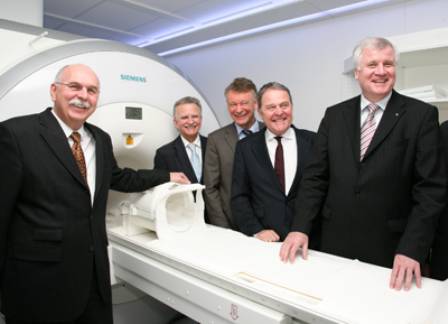Siemens unveils first whole-body MR-PET system with simultaneous data acquisition
23 Nov 2010
Siemens Healthcare will unveil at the end of this month the Biograph mMR, the world's first integrated whole-body molecular magnetic resonance (MR) imaging system with simultaneous PET and MR data acquisition technology.
Currently undergoing clinical use testing (so not commercially available yet), this revolutionary system comprises an MR scanner and an integrated Positron Emission Tomography (PET) detection system with an architecture that performs as one. It will be unveiled at the 96th Scientific Assembly and Annual Meeting of the Radiological Society of North America (RSNA), 28 November - 2 December 2010 in Chicago.
In the new 3-Tesla hybrid system, Siemens developers have succeeded for the first time in simultaneously capturing MR and PET data with a whole-body system. The Biograph mMR system has been installed at the University Hospital Klinikum rechts der Isar of the Munich Technical University in Germany.
"Together with our partner Siemens, we are entering a new dimension in diagnostic imaging today," says Prof. Dr. Markus Schwaiger, Director of the Clinic for Nuclear Medicine at the University Hospital. "We've initiated clinical use testing of the Biograph mMR in an effort to diagnose diseases at a very early stage to see the progression of disease and to use that information to develop a therapy plan precisely focused on the respective patient. Furthermore, we plan to use the system for cancer follow-up in the long run, by reducing radiation exposure by the use of the system."
With the simultaneous acquisition of MR and PET data, this system is designed to provide new opportunities for imaging. While MR provides exquisite morphological and functional details in human tissue, PET goes further to investigate the human body at the level of cellular activity and metabolism.
The innovative system has the potential to be a particularly valuable tool for identifying neurological, oncological and cardiac conditions of disease and in supporting the planning of appropriate therapies. Since MRI does not emit ionizing radiation, Biograph mMR may provide an added benefit with lower-dose imaging. The Biograph mMR also opens new opportunities for research, such as the development of new biomarkers or new therapeutic approaches.

The Biograph mMR system has been installed at
the university hospital Klinikum rechts der Isar of the Munich
Technical University, Germany. The picture shows (from left to
right): Prof. Dr.-Ing. Matthias Kleiner (Deutsche
Forschungsgemeinschaft), Prof. Dr. Reiner Gradinger (Medical
Director at Klinikum rechts der Isar), Prof. Dr. Hermann Requardt
(Sector CEO Siemens Healthcare), Dr. Wolfgang Heubisch (Bavarian
State Minister of Sciences, Research and the Arts) and Horst
Seehofer (Minister President of Bavaria).
"Biograph mMR is the latest breakthrough innovation of Siemens in the field of diagnostic imaging. It will be a new instrument for driving personalized medicine forward," says Walter Maerzendorfer, CEO, Magnetic Resonance at Siemens Healthcare.
"Biograph mMR is designed to simultaneously acquire morphology, function, and metabolism for the entire body," adds Britta Fuenfstueck, CEO, Molecular Imaging at Siemens Healthcare.
MR and PET have become an established part of everyday healthcare routines and have proven themselves to be valuable clinical diagnostic tools. The integration of these two technologies into a single system capable of simultaneous acquisition brings the potential to revolutionize the diagnosis of many conditions. Initial research suggests that with this system, Molecular MR can scan the entire body in as little as 30 minutes for the combined exams, compared to one hour or more for sequential MR and PET examinations.
Siemens envisions a wide range of clinical applications for molecular MR, including the early identification and staging of malignancies, therapy planning (including surgery planning) and therapy control.
A technical revolution
Until now, it was nearly impossible to integrate MR and PET technologies: the conventional PET detectors, which use photomultiplier tubes, could not be used in the strong magnetic field generated by an MR system as they were affected by magnetism. Integration was further limited by the lack of space inside the MR device. For this reason, MR-PET imaging is normally acquired by two separate scans with a significant time lag. With Biograph mMR, Siemens brings the first molecular MR system for clinical research that integrates MR with compact, specialized PET detectors.